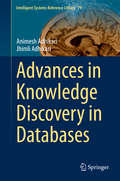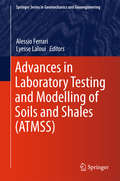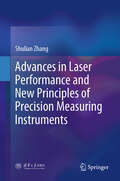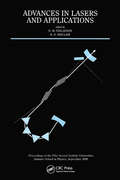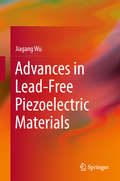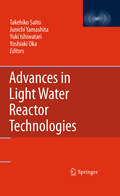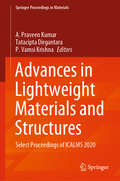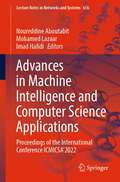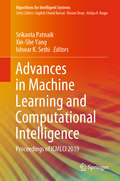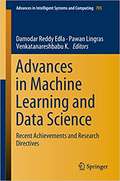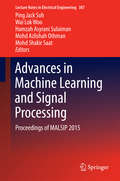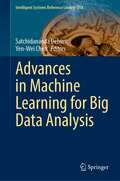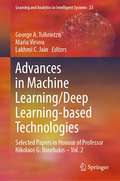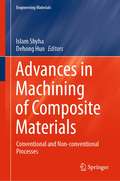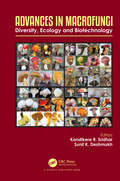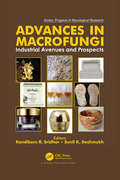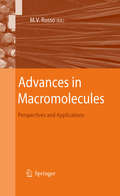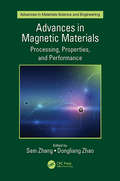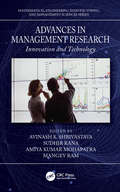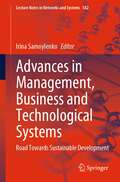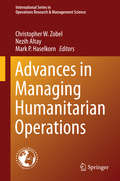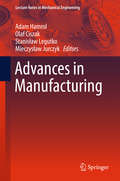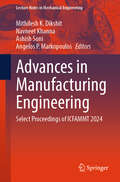- Table View
- List View
Advances in Knowledge Discovery in Databases (Intelligent Systems Reference Library #79)
by Animesh Adhikari Jhimli AdhikariThis book presents recent advances in Knowledge discovery in databases (KDD) with a focus on the areas of market basket database, time-stamped databases and multiple related databases. Various interesting and intelligent algorithms are reported on data mining tasks. A large number of association measures are presented, which play significant roles in decision support applications. This book presents, discusses and contrasts new developments in mining time-stamped data, time-based data analyses, the identification of temporal patterns, the mining of multiple related databases, as well as local patterns analysis.
Advances in Laboratory Testing and Modelling of Soils and Shales (Springer Series in Geomechanics and Geoengineering)
by Lyesse Laloui Alessio FerrariIn this spirit, the ATMSS International Workshop "Advances in Laboratory Testing & Modelling of Soils and Shales" (Villars-sur-Ollon, Switzerland; 18-20 January 2017) has been organized to promote the exchange of ideas, experience and state of the art among major experts active in the field of experimental testing and modelling of soils and shales. The Workshop has been organized under the auspices of the Technical Committees TC-101 "Laboratory Testing", TC-106 "Unsaturated Soils" and TC-308 "Energy Geotechnics" of the International Society of Soil Mechanics and Geotechnical Engineering. This volume contains the invited keynote and feature lectures, as well as the papers that have been presented at the Workshop. The topics of the lectures and papers cover a wide range of theoretical and experimental research, including unsaturated behaviour of soils and shales, multiphysical testing of geomaterials, hydro-mechanical behaviour of shales and stiff clays, the geomechanical behaviour of the Opalinus Clay shale, advanced laboratory testing for site characterization and in-situ applications, and soil - structure interactions.
Advances in Laser Performance and New Principles of Precision Measuring Instruments
by Shulian ZhangThis book highlights a comprehensive introduction to double-beam laser and its application to a series of innovative instruments for precision measurement. The first two chapters introduce the structures and properties of double-beam laser, which become the foundation of more than a dozen innovative instruments in the second half of the book. The book covers two types of lasers: the frequency-split orthogonal-polarization HeNe lasers and the microchip solid-state lasers. Surrounding the two types of lasers, the book introduces 13 innovative instruments that can be widely applied to the precision measurement in scientific research, lithography, CNC machine tools, astronautics, and shipbuilding. The book is rich in research data that are all-round and repeatable, which can inspire future research and development of the technology, instruments, as well as application scenarios. The book is used as a valuable reference for researchers, engineers, and students who seek to further bridge laser and precision measurement.
Advances in Lasers and Applications
by D.M. Finlayson B SinclairAdvances in Lasers and Applications opens with tutorial reviews of the underpinning science of diode pumped lasers, optical parametric oscillators, and ultrafast pulse generation. The book proceeds to the more specialized areas of waveguide lasers, ultrafast parametric amplification, visible solid-state lasers, materials, and diode pumps. The final sections present the applications of these sources to medicine, remote sensing and ranging, materials processing, and the widening set of applications for ultrashort pulses.
Advances in Lead-Free Piezoelectric Materials
by Jiagang WuThis book systematically reviews the history of lead-free piezoelectric materials, including the latest research. It also addresses a number of important issues, such as new types of materials prepared in a multitude of sizes, structural and physical properties, and potential applications for high-performance devices.Further, it examines in detail the state of the art in lead-free piezoelectric materials, focusing on the pathways to modify different structures and achieve enhanced physical properties and new functional behavior. Lastly, it discusses the prospects for potential future developments in lead-free piezoelectric materials across disciplines and for multifunctional applications. Given its breadth of coverage, the book offers a comprehensive resource for graduate students, academic researchers, development scientists, materials producers, device designers and applications engineers who are working on or are interested in advanced lead-free piezoelectric materials.
Advances in Light Water Reactor Technologies
by Yuki Ishiwatari Yoshiaki Oka Junichi Yamashita Takehiko SaitoAdvances in Light Water Reactor Technologies focuses on the design and analysis of advanced nuclear power reactors. This volume provides readers with thorough descriptions of the general characteristics of various advanced light water reactors currently being developed worldwide. Safety, design, development and maintenance of these reactors is the main focus, with key technologies like full MOX core design, next-generation digital I&C systems and seismic design and evaluation described at length. This book is ideal for researchers and engineers working in nuclear power that are interested in learning the fundamentals of advanced light water plants.
Advances in Lightweight Materials and Structures: Select Proceedings of ICALMS 2020 (Springer Proceedings in Materials #8)
by P. Vamsi Krishna A. Praveen Kumar Tatacipta DirgantaraThis book presents select proceedings of the International Conference on Advanced Lightweight Materials and Structures (ICALMS) 2020, and discusses the triad of processing, structure, and various properties of lightweight materials. It provides a well-balanced insight into materials science and mechanics of both synthetic and natural composites. The book includes topics such as nano composites for lightweight structures, impact and failure of structures, biomechanics and biomedical engineering, nanotechnology and micro-engineering, tool design and manufacture for producing lightweight components, joining techniques for lightweight structures for similar and dissimilar materials, design for manufacturing, reliability and safety, robotics, automation and control, fatigue and fracture mechanics, and friction stir welding in lightweight sandwich structures. The book also discusses latest research in composite materials and their applications in the field of aerospace, construction, wind energy, automotive, electronics and so on. Given the range of topics covered, this book can be a useful resource for beginners, researchers and professionals interested in the wide ranging applications of lightweight structures.
Advances in Machine Intelligence and Computer Science Applications: Proceedings of the International Conference ICMICSA’2022 (Lecture Notes in Networks and Systems #656)
by Mohamed Lazaar Noureddine Aboutabit Imad HafidiThis book encloses latest and advanced researches on artificial intelligence and its applications in computer science. It is an interesting book that aims to help students, researchers, industrialists, and policymakers understand, promote, and synthesize innovative solutions and think of new ideas with the application of artificial intelligence concepts. It also allows to know the existing scientific works and contributions in the literature. This book identifies original research in new directions and advances focused on multidisciplinary areas and closely related to the use of artificial intelligence in applications of computer science, communication, and technology. The present book contains selected and extended high-quality papers of the 1st international conference on Machine Intelligence and Computer Science Applications (ICMICSA’2022). It is the result of a reviewed, evaluated, and presented work in ICMICSA’2022 held on November 28–29, 2022, in Khouribga, Morocco.
Advances in Machine Learning and Computational Intelligence: Proceedings of ICMLCI 2019 (Algorithms for Intelligent Systems)
by Xin-She Yang Ishwar K. Sethi Srikanta PatnaikThis book gathers selected high-quality papers presented at the International Conference on Machine Learning and Computational Intelligence (ICMLCI-2019), jointly organized by Kunming University of Science and Technology and the Interscience Research Network, Bhubaneswar, India, from April 6 to 7, 2019. Addressing virtually all aspects of intelligent systems, soft computing and machine learning, the topics covered include: prediction; data mining; information retrieval; game playing; robotics; learning methods; pattern visualization; automated knowledge acquisition; fuzzy, stochastic and probabilistic computing; neural computing; big data; social networks and applications of soft computing in various areas.
Advances in Machine Learning and Data Science: Recent Achievements And Research Directives (Advances In Intelligent Systems And Computing #705)
by Pawan Lingras Damodar Reddy Venkatanareshbabu KuppiliPresents studies involving innovative combination of machine learning and data science.<P><P> Presents latest ideas and techniques in the field of data mining.<P> Serves as a good reference material for future work.<P> The Volume of “Advances in Machine Learning and Data Science - Recent Achievements and Research Directives” constitutes the proceedings of First International Conference on Latest Advances in Machine Learning and Data Science (LAMDA 2017). The 37 regular papers presented in this volume were carefully reviewed and selected from 123 submissions.<P> These days we find many computer programs that exhibit various useful learning methods and commercial applications. Goal of machine learning is to develop computer programs that can learn from experience. Machine learning involves knowledge from various disciplines like, statistics, information theory, artificial intelligence, computational complexity, cognitive science and biology. For problems like handwriting recognition, algorithms that are based on machine learning out perform all other approaches. Both machine learning and data science are interrelated. Data science is an umbrella term to be used for techniques that clean data and extract useful information from data. In field of data science, machine learning algorithms are used frequently to identify valuable knowledge from commercial databases containing records of different industries, financial transactions, medical records, etc.<P> The main objective of this book is to provide an overview on latest advancements in the field of machine learning and data science, with solutions to problems in field of image, video, data and graph processing, pattern recognition, data structuring, data clustering, pattern mining, association rule based approaches, feature extraction techniques, neural networks, bio inspired learning and various machine learning algorithms.
Advances in Machine Learning and Signal Processing: Proceedings of MALSIP 2015 (Lecture Notes in Electrical Engineering #387)
by Ping Jack Soh Wai Lok Woo Hamzah Asyrani Sulaiman Mohd Azlishah Othman Mohd Shakir SaatThisbook presents important research findings and recent innovations in the fieldof machine learning and signal processing. A wide range of topics relating to machinelearning and signal processing techniques and their applications are addressed inorder to provide both researchers and practitioners with a valuable resourcedocumenting the latest advances and trends. The book comprises a carefulselection of the papers submitted to the 2015 International Conference on MachineLearning and Signal Processing (MALSIP 2015), which was held on 15-17 December2015 in Ho Chi Minh City, Vietnam with the aim of offering researchers,academicians, and practitioners an ideal opportunity to disseminate theirfindings and achievements. All of the included contributions were chosen byexpert peer reviewers from across the world on the basis of their interest tothe community. In addition to presenting the latest in design, development, andresearch, the book provides access to numerous new algorithms for machinelearning and signal processing for engineering problems.
Advances in Machine Learning for Big Data Analysis (Intelligent Systems Reference Library #218)
by Satchidananda Dehuri Yen-Wei ChenThis book focuses on research aspects of ensemble approaches of machine learning techniques that can be applied to address the big data problems. In this book, various advancements of machine learning algorithms to extract data-driven decisions from big data in diverse domains such as the banking sector, healthcare, social media, and video surveillance are presented in several chapters. Each of them has separate functionalities, which can be leveraged to solve a specific set of big data applications. This book is a potential resource for various advances in the field of machine learning and data science to solve big data problems with many objectives. It has been observed from the literature that several works have been focused on the advancement of machine learning in various fields like biomedical, stock prediction, sentiment analysis, etc. However, limited discussions have been carried out on application of advanced machine learning techniques in solving big data problems.
Advances in Machine Learning/Deep Learning-based Technologies: Selected Papers in Honour of Professor Nikolaos G. Bourbakis – Vol. 2 (Learning and Analytics in Intelligent Systems #23)
by Lakhmi C. Jain Maria Virvou George A. TsihrintzisAs the 4th Industrial Revolution is restructuring human societal organization into, so-called, “Society 5.0”, the field of Machine Learning (and its sub-field of Deep Learning) and related technologies is growing continuously and rapidly, developing in both itself and towards applications in many other disciplines. Researchers worldwide aim at incorporating cognitive abilities into machines, such as learning and problem solving. When machines and software systems have been enhanced with Machine Learning/Deep Learning components, they become better and more efficient at performing specific tasks. Consequently, Machine Learning/Deep Learning stands out as a research discipline due to its worldwide pace of growth in both theoretical advances and areas of application, while achieving very high rates of success and promising major impact in science, technology and society. The book at hand aims at exposing its readers to some of the most significant Advances in Machine Learning/Deep Learning-based Technologies. The book consists of an editorial note and an additional ten (10) chapters, all invited from authors who work on the corresponding chapter theme and are recognized for their significant research contributions. In more detail, the chapters in the book are organized into five parts, namely (i) Machine Learning/Deep Learning in Socializing and Entertainment, (ii) Machine Learning/Deep Learning in Education, (iii) Machine Learning/Deep Learning in Security, (iv) Machine Learning/Deep Learning in Time Series Forecasting, and (v) Machine Learning in Video Coding and Information Extraction. This research book is directed towards professors, researchers, scientists, engineers and students in Machine Learning/Deep Learning-related disciplines. It is also directed towards readers who come from other disciplines and are interested in becoming versed in some of the most recent Machine Learning/Deep Learning-based technologies. An extensive list of bibliographic references at the end of each chapter guides the readers to probe further into the application areas of interest to them.
Advances in Machining of Composite Materials: Conventional and Non-conventional Processes (Engineering Materials)
by Dehong Huo Islam ShyhaThis book covers a wide range of conventional and non-conventional machining processes of various composite materials, including polymer and metallic-based composites, nanostructured composites and green/natural composites. It presents state-of-the-art academic work and industrial developments in material fabrication, machining, modelling and applications, together with current practices and requirements for producing high-quality composite components. There are also dedicated chapters on physical properties and fabrication techniques of different composite material groups. The book also has chapters on health and safety considerations when machining composite materials and recycling composite materials. The contributors present machining composite materials in terms of operating conditions; cutting tools; appropriate machines; and typical damage patterns following machining operations. This book serves as a useful reference for manufacturing engineers, production supervisors, tooling engineers, planning and application engineers, and machine tool designers. It can also benefit final-year undergraduate and postgraduate students, as it provides comprehensive information on the machining of composite materials to produce high-quality final components. The book chapters were authored by experienced academics and researchers from four continents and nine countries including Canada, China, Egypt, India, Malaysia, Portugal, Singapore, United Kingdom and the USA.
Advances in Macrofungi: Diversity, Ecology and Biotechnology
by Kandikere Ramaiah Sridhar Sunil Kumar DeshmukhAdvances in Macrofungi: Diversity, Ecology and Biotechnology discusses the diversity and ecology of edible, toxic, medicinal and mycorrhizal macrofungi; the impact of ectomycorrhizal fungi in terrestrial ecosystems, ectomycorrhizal complex in Boreal forests and commercial application of Pseudotsuga in silviculture; the nutritional evaluation and cultivation of edible wild mushrooms; the diversity of novel metabolites of macrofungi useful in food, pharmaceutical and cosmeceutical industries; mushrooms as tool for eco-friendly synthesis of nanoparticles and proteomics of edible and medicinal mushrooms. In addition, it covers experimental designs, methodological approaches, biogeochemical cycles, conceptual/hypothetical models and life history strategies, linking mycorrhizal diversity to plant performance, chemotaxonomy, role of mycorrhizae in forestry and macrofungi in nanotechnology. It provides a valuable resource to graduate, post-graduate and researchers (in botany, microbiology, ecology, biotechnology, forestry, life sciences and environmental sciences) to understand the diversity, ecology, therapeutic value, mutualistic associations and biotechnological potential of macrofungi.
Advances in Macrofungi: Industrial Avenues and Prospects (Progress in Mycological Research)
by Kandikere R. SridharLarge scale cultivation of macrofungi is possible with fermentation, using easily accessible lignocellulosic agricultural residues applying economical methods to generate substantial biomass, food and biofuels. Bioconversion of lignocellulosic wastes by macrofungi generates value-added fungal nutritional biomass for humans and livestock. Besides commercial cultivation techniques, other topics covered in Advances in Macrofungi: Industrial Avenues and Prospects include: the healing potential of mushrooms, industrial opportunities, mycelium-based products, forest wild mushrooms and industrial applications of white rot fungi. This book reviews the industrial applications and uses of macrofungi. It encourages students and researchers to explore non-conventional sources of nutrition as well as bioactive metabolites to serve as nutraceuticals. It emphasizes the potential of macrofungi as a source of bioactive compounds to remedy human lifestyle diseases especially cancers and cardiovascular ailments along with immunostimulation potential by Cordyceps. This book emphasizes the role of on mushrooms as a source of cosmeceuticals, flavors, essence, scents and perfumes.
Advances in Macromolecules: Perspectives and Applications
by Maria Vittoria Russo"Polymeric and Nanostructured Macromolecules" presents the recent advances made in the synthesis, characterization, and applications of polymeric macromolecules. This book provides an excellent overview of the recent breakthroughs in the science of macromolecules, with an emphasis on nanostructured macromolecules and the perspectives that these versatile materials offer to different fields such as optoelectronics and biotechnology. Advanced undergraduate, graduate students and researchers alike will find the topics concerning physical and chemical properties of advanced macromolecular materials of great interest.
Advances in Magnetic Materials: Processing, Properties, and Performance (Advances in Materials Science and Engineering)
by Sam Zhang Dongliang ZhaoAdvances in Magnetic Materials: Processing, Properties, and Performance discusses recent developments of magnetic materials, including fabrication, characterization and applications in the aerospace, biomedical, and semiconductors industries. With contributions by international professionals who possess broad and varied expertise, this volume encompasses both bulk materials and thin films and coatings for magnetic applications. A timely reference book that describes such things as ferromagnetism, nanomaterials, and Fe, ZnO, and Co-based materials, Advances in Magnetic Materials is an ideal text for students, researchers, and professionals working in materials science. Describes recent developments of magnetic materials, including fabrication, characterization, and applications Addresses a variety of industrial applications, such as aerospace, biomedical, and semiconductors Discusses bulk materials and thin films and coatings Covers ferromagnetism, nanomaterials, Fe, ZnO, and Co-based materials Contains the contributions of international professionals with broad and varied expertise Covers a holistic range of magnetic materials in various aspects of process, properties, and performance
Advances in Management Research: Innovation and Technology (Mathematical Engineering, Manufacturing, and Management Sciences)
by Mangey Ram Avinash K. Shrivastava Sudhir Rana Amiya Kumar MohapatraThis book covers advancements across business domains in knowledge and information management. It presents research trends in the fields of management, innovation, and technology, and is composed of research papers that show applications of IT, analytics, and business operations in industry and in educational institutions. It offers a combination of scientific research methods and concepts, with contributions from globally renowned authors; presents various management domains from a number of countries for a global perspective; and provides a unique combination of topics and methods while giving insights on the management domain using a holistic approach. The book provides scholars with a platform to derive maximum utility in the area of management, research, and technology by subscribing to the idea of managing business through performance and management technology.
Advances in Management, Business and Technological Systems: Road Towards Sustainable Development (Lecture Notes in Networks and Systems #582)
by Irina SamoylenkoEconomic development, social sustainability, and environmental protection play a major role in terms of efforts for innovation, digitalization, business, and global development. Today, nations all over the world attempt to accomplish the United Nations Sustainable Development Goals and to ensure sustainable patterns. Combining empirical and theoretical information, this book demonstrates advanced initiatives and concrete examples from universities, research institutes, and companies, regarding cross-cutting issues in sustainable development of a wide range of fields. The major focus in the book is the promotion of quality of life, by means of a more sustainable food production, and improved food security. Additionally, the importance of digital technologies, business policy, social aspects, and corporate governance in ensuring sustainable regional development is studied. This book is a truly interdisciplinary publication, useful to scholars, social movements, practitioners, and members of governmental agencies and private companies.
Advances in Managing Humanitarian Operations (International Series in Operations Research & Management Science #235)
by Nezih Altay Christopher W. Zobel Mark P. HaselkornThis volume provides a survey of current research problems and results in humanitarian operations research. Additionally, it discusses existing applications of humanitarian operations research, and considers new research efforts that clearly extend existing research and applications. The book is divided into three sections that provide an overview of the subject, a look at the theory, and an examination of applications. The overview section presents chapters on modeling approaches and metrics to evaluate nonprofit operations; chief findings of fieldwork research in disaster response logistics; the use of cash as a form of relief; and measuring markets that supply cash-based humanitarian interventions. The theory section includes chapters that examine the partner proliferation problem in disaster response networks; a case study of humanitarian logistics that examines how humanitarian culture informs change adoption; and a look at the current state of the art for information visibility in humanitarian operations. Finally, the application section focuses on blood products, vaccines, and food assistance, with individual chapters on efficient inventorying and distribution of blood products during disasters; a detailed look at modeling in the context of the vaccine supply chain; a framework for achieving equity, effectiveness, and efficiency in food bank operations; and a spatio-temporal vulnerabili ty assessment of the resilience of a population affected by sudden lack of food.
Advances in Manufacturing (Lecture Notes in Mechanical Engineering)
by Adam Hamrol Olaf Ciszak Stanisław Legutko Mieczysław JurczykThis book covers a variety of topics in material, mechanical, and management engineering, especially in the area of machine design, product assembly, measurement systems, process planning and quality control. It describes cutting-edge methods and applications, together with exemplary case studies. The content is based on papers presented at the 5th International Scientific-Technical Conference (MANUFACTURING 2017) held in Poznan, Poland on 24-26 October 2017. The book brings together engineering and economic topics, is intended as an extensive, timely and practice-oriented reference guide for researchers and practitioners, and is expected to foster better communication and closer cooperation between universities and their business and industry partners.
Advances in Manufacturing Engineering and Materials II: Proceedings of the International Conference on Manufacturing Engineering and Materials (ICMEM 2020), 21–25 June, 2021, Nový Smokovec, Slovakia (Lecture Notes in Mechanical Engineering)
by Sergej Hloch Dagmar Klichová Grzegorz M. Krolczyk Somnath Chattopadhyaya Frank PudeThis book reports on cutting-edge research and technologies in the field of advanced manufacturing and materials, with a special emphasis on unconventional machining process, rapid prototyping and biomaterials. It gathers contributions to the International Conference on Manufacturing Engineering and Materials (ICMEM 2020), which was originally planned in June 2020, but will actually take place in 2021, in Nový Smokovec, Slovakia, because of the Covid-19 pandemic. Despite the challenging times, submitted contributions were peer-reviewed, and upon a careful revision, included in this book, which covers advances that are expected to increase the industry’s competitiveness with regard to sustainable development and preservation of the environment and natural resources. Condition monitoring, industrial automation, and diverse fabrication processes such as welding, casting and molding, as well as tribology and bioengineering, are just a few of the topics discussed in the book’s wealth of authoritative contributions. A special emphasis is given to problems connected to climate change and solution manufacturer and engineers may adopt and develop to prevent and cope with them.
Advances in Manufacturing Engineering: Select Proceedings of ICFAMMT 2022 (Lecture Notes in Mechanical Engineering)
by J. Paulo Davim Mithilesh K. Dikshit Ashish SoniThis book presents select peer-reviewed proceedings of the International Conference on Futuristic Advancements in Materials, Manufacturing, and Thermal Sciences (ICFAMMT 2022). The contents of this book provide an overview of the latest research in the area of manufacturing sciences such as metal cutting, metal forming, casting, joining, micromachining, nonconventional machining, and additive manufacturing. Some of the other themes covered in this book are metal-based additive manufacturing, polymer-based additive manufacturing, hybrid additive manufacturing, optimization approach for minimizing GD, and error in additive manufactured parts. The book will be useful for researchers and professionals working in the field of manufacturing engineering.
Advances in Manufacturing Engineering: Select Proceedings of ICFAMMT 2024 (Lecture Notes in Mechanical Engineering)
by Angelos P. Markopoulos Mithilesh K. Dikshit Ashish Soni Navneet KhannaThis book presents the select proceedings of 2nd International Conference on Futuristic Advancements in Materials, Manufacturing and Thermal Sciences (ICFAMMT 2024). It covers the latest research in manufacturing sciences and technology, including metal cutting, metal forming, casting, joining, micromachining, nonconventional machining, and additive manufacturing. The book also covers topics such as industry 4.0, digital manufacturing, and the use of artificial intelligence and machine learning in the manufacturing industry, cryogenic machining, dry and near-dry machining, and additive manufacturing, including metal-based additive manufacturing, polymer-based additive manufacturing, and hybrid additive manufacturing. The book is useful for researchers and professionals working in the field of manufacturing sciences.
